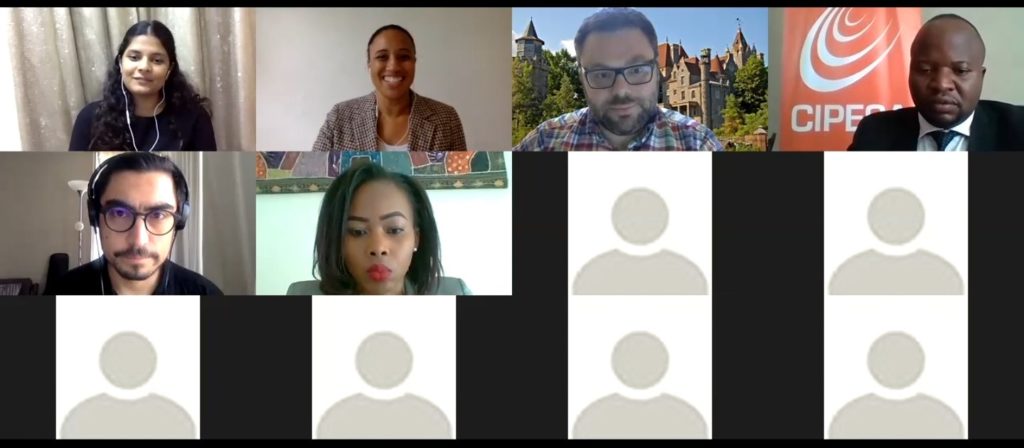
By Shreya Tewari
In September 2020, the Catalysts for Collaboration project was showcased and relaunched at the Forum on Internet Freedom in Africa, 2020. The collaboration-oriented model that the project introduces has been used worldwide to help develop better practices for strategic litigation.
For the relaunch of the project at FIFAfrica 2020, we had a line-up of excellent panellists joining us from across continents, who had been a part of the project in its different stages.
The catalysts were first developed in 2017 by Nani Jansen Reventlow during her time as a Fellow at Harvard University’s Berkman Klein Center. They embody best practices for collaboration in strategic litigation such as ‘Planning as a group’, ‘Embracing the tech’ and ‘Involving your stakeholders’, among others. They were the result of multi-stakeholder meetings held with litigators from various jurisdictions. The catalysts were then complemented by case studies of strategic litigation efforts whose outcomes were heavily influenced by collaboration and where the catalysts had organically emerged as the tools that were used for it.
In September 2020, the project was relaunched in four languages and with two additional case studies from Kenya and Spainhttps://www.derechosdigitales.org/. For the relaunch of the project at FIFAfrica 2020, we had a line-up of excellent panellists joining us from across continents, who had been a part of the project in its different stages. Mason Kortz, clinical instructor at Harvard Law School’s Cyberlaw Clinic, was instrumental in helping shape the catalysts themselves. Wakesho Kililo, an independent lawyer at the High Court of Kenya, who was a featured actor in the Kenyan Biometric case study; Juan Carlos Lara, Research and Public Policy Director at Derechos Digitales, who was a critical part of the Surveillance Balloons in Chile case study, and Edrine Wanyama, Legal Officer at CIPESA, who had used the catalysts to develop and analyse case studies in Africa. I had the pleasure of co-moderating the session along with Jansen Reventlow.
The session opened with Kortz discussing how the catalysts had taken shape. He spoke of how the original concepts that Jansen Reventlow put together were vetted and mulled over by fifteen stakeholders from different disciplines and culminated into 60-70 discrete pieces of advice that people wanted to convey to practitioners. The next step was to distil these pieces of advice into twelve catalysts that represented the combined knowledge of lawyers, activists, academics, and technologists around the world who produced these common themes for collaborations.
Next, I had the pleasure of speaking about my experience developing the case studies. The most fascinating aspect of this for me was observing that each actor had a different story of how a catalyst had enabled successful litigation and the multi-jurisdictional and inter-disciplinary litigation projects that they have been used in. This shed light on how the catalysts were far from scientific principles that had to be uniformly applied to scenarios to reach pre-determined outcomes. Instead, they were unique action verbs that depicted and focused on more than just an outcome – they depicted how each unique journey can benefit from collaboration.
Each actor had a different story of how a catalyst had enabled successful litigation and the multi-jurisdictional and inter-disciplinary litigation projects that they have been used in.
Kililo shed light on the advantages of planning as a group in Kenya’s Biometric ID Case and how that allowed the team to harness the resources and expertise of each member in the team. She also laid emphasis on the strategic victories in the litigation by noting how it made way for Kenya’s first-ever Data Protection Bill. She concluded by drawing attention to the catalyst of involving the stakeholders and how that enabled public discourse on important issues leading to larger social change.
Lara spoke of his experience of learning to collaborate at the helm of Derechos Digitales in its first strategic litigation. He spoke of the need for constant collaboration at every stage of the litigation and even more so, due to the opaque nature of the technology being used by the government when deploying surveillance balloons over municipalities in Santiago. He emphasised how organisations with different areas of expertise came together to get the media involved to generate a larger debate on the issue. Most importantly, he noted that despite their loss in court, the momentum of the larger debate was used to move the conversation forward and motivated much-needed regulation and policy change.
Finally, we heard Wanyama talk about his own experience of using the catalysts to develop cases studies in Africa. He noted that his objective behind the analysis was to identify instances where the catalysts had been unknowingly employed in the litigation. Like Lara, he also emphasised how the outcome of a case may not be what was anticipated. However, importantly, he noted that in strategic litigation, just the decision to initiate a case is a move enough to show that the cause was something worth fighting for.
In strategic litigation, just the decision to initiate a case is a move enough to show that the cause was something worth fighting for.
As the session drew to a close, we learned more about the panellists’ most-cherished catalysts, where catalyst five was a very popular one: respect and acknowledge your collaborators. In the end, the panellists and audience went back feeling more hopeful and equipped to push for broader social change through successful collaborations.
